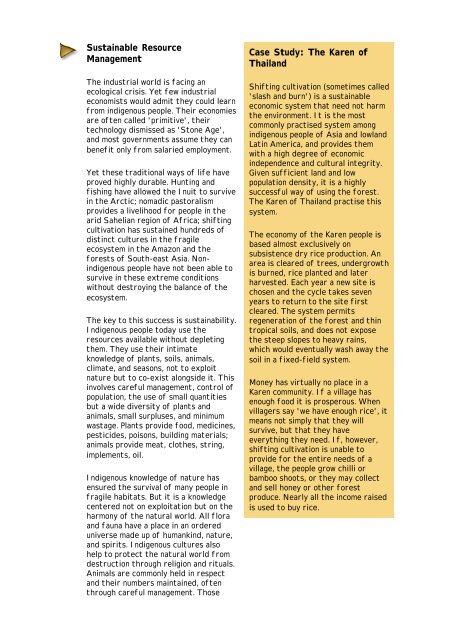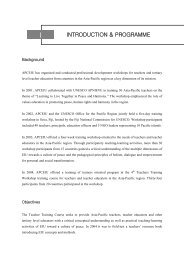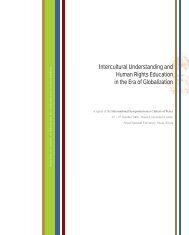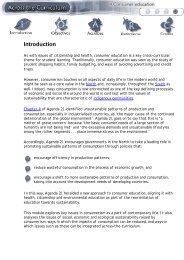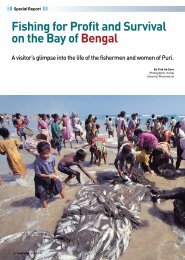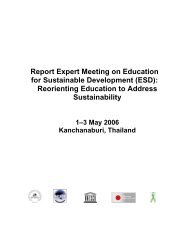Module 11 | Indigenous knowledge and sustainability - APCEIU
Module 11 | Indigenous knowledge and sustainability - APCEIU
Module 11 | Indigenous knowledge and sustainability - APCEIU
Create successful ePaper yourself
Turn your PDF publications into a flip-book with our unique Google optimized e-Paper software.
Sustainable Resource<br />
Management<br />
The industrial world is facing an<br />
ecological crisis. Yet few industrial<br />
economists would admit they could learn<br />
from indigenous people. Their economies<br />
are often called 'primitive', their<br />
technology dismissed as 'Stone Age',<br />
<strong>and</strong> most governments assume they can<br />
benefit only from salaried employment.<br />
Yet these traditional ways of life have<br />
proved highly durable. Hunting <strong>and</strong><br />
fishing have allowed the Inuit to survive<br />
in the Arctic; nomadic pastoralism<br />
provides a livelihood for people in the<br />
arid Sahelian region of Africa; shifting<br />
cultivation has sustained hundreds of<br />
distinct cultures in the fragile<br />
ecosystem in the Amazon <strong>and</strong> the<br />
forests of South-east Asia. Nonindigenous<br />
people have not been able to<br />
survive in these extreme conditions<br />
without destroying the balance of the<br />
ecosystem.<br />
The key to this success is <strong>sustainability</strong>.<br />
<strong>Indigenous</strong> people today use the<br />
resources available without depleting<br />
them. They use their intimate<br />
<strong>knowledge</strong> of plants, soils, animals,<br />
climate, <strong>and</strong> seasons, not to exploit<br />
nature but to co-exist alongside it. This<br />
involves careful management, control of<br />
population, the use of small quantities<br />
but a wide diversity of plants <strong>and</strong><br />
animals, small surpluses, <strong>and</strong> minimum<br />
wastage. Plants provide food, medicines,<br />
pesticides, poisons, building materials;<br />
animals provide meat, clothes, string,<br />
implements, oil.<br />
<strong>Indigenous</strong> <strong>knowledge</strong> of nature has<br />
ensured the survival of many people in<br />
fragile habitats. But it is a <strong>knowledge</strong><br />
centered not on exploitation but on the<br />
harmony of the natural world. All flora<br />
<strong>and</strong> fauna have a place in an ordered<br />
universe made up of humankind, nature,<br />
<strong>and</strong> spirits. <strong>Indigenous</strong> cultures also<br />
help to protect the natural world from<br />
destruction through religion <strong>and</strong> rituals.<br />
Animals are commonly held in respect<br />
<strong>and</strong> their numbers maintained, often<br />
through careful management. Those<br />
Case Study: The Karen of<br />
Thail<strong>and</strong><br />
Shifting cultivation (sometimes called<br />
'slash <strong>and</strong> burn') is a sustainable<br />
economic system that need not harm<br />
the environment. It is the most<br />
commonly practised system among<br />
indigenous people of Asia <strong>and</strong> lowl<strong>and</strong><br />
Latin America, <strong>and</strong> provides them<br />
with a high degree of economic<br />
independence <strong>and</strong> cultural integrity.<br />
Given sufficient l<strong>and</strong> <strong>and</strong> low<br />
population density, it is a highly<br />
successful way of using the forest.<br />
The Karen of Thail<strong>and</strong> practise this<br />
system.<br />
The economy of the Karen people is<br />
based almost exclusively on<br />
subsistence dry rice production. An<br />
area is cleared of trees, undergrowth<br />
is burned, rice planted <strong>and</strong> later<br />
harvested. Each year a new site is<br />
chosen <strong>and</strong> the cycle takes seven<br />
years to return to the site first<br />
cleared. The system permits<br />
regeneration of the forest <strong>and</strong> thin<br />
tropical soils, <strong>and</strong> does not expose<br />
the steep slopes to heavy rains,<br />
which would eventually wash away the<br />
soil in a fixed-field system.<br />
Money has virtually no place in a<br />
Karen community. If a village has<br />
enough food it is prosperous. When<br />
villagers say 'we have enough rice', it<br />
means not simply that they will<br />
survive, but that they have<br />
everything they need. If, however,<br />
shifting cultivation is unable to<br />
provide for the entire needs of a<br />
village, the people grow chilli or<br />
bamboo shoots, or they may collect<br />
<strong>and</strong> sell honey or other forest<br />
produce. Nearly all the income raised<br />
is used to buy rice.


